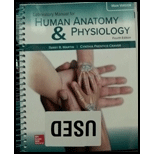
Laboratory Manual For Human Anatomy & Physiology
4th Edition
ISBN: 9781260159080
Author: Martin, Terry R., Prentice-craver, Cynthia
Publisher: Mcgraw-hill Education,
expand_more
expand_more
format_list_bulleted
Textbook Question
Chapter 47, Problem 1.2A
Describe the differences you noted in the structures of the arterial and venous walls. Mention each of the three layers of the wall.
Expert Solution & Answer
Want to see the full answer?
Check out a sample textbook solution
Students have asked these similar questions
State the five functions of Globular Proteins, and give an example of a protein for each function.
Diagram of check cell under low power and high power
a couple in which the father has the a blood type and the mother has the o blood type produce an offspring with the o blood type, how does this happen? how could two functionally O parents produce an offspring that has the a blood type?
Chapter 47 Solutions
Laboratory Manual For Human Anatomy & Physiology
Ch. 47 - The middle layer of an artery and vein contains...Ch. 47 - Arteries carry blood a. away from the heart. b....Ch. 47 - The ________ has the thickest wall. a. right...Ch. 47 - Which of the following arteries is not a direct...Ch. 47 - Which of the following veins is nor located in the...Ch. 47 - Which of the following arteries is part of the...Ch. 47 - A capillary wall is composed of three tunic s...Ch. 47 - The left ventricle pumps blood into the aorta of...Ch. 47 - Sketch and label a section of an arterial wall...Ch. 47 - Describe the differences you noted in the...
Ch. 47 - Describe the differences you noted in the...Ch. 47 - How did you distinguish between arterioles and...Ch. 47 - How did you recognize capillaries in the web?Ch. 47 - Brachiocephalic trunk, _____, right axillary...Ch. 47 - Ascending aorta, ______, descending thoracic aortaCh. 47 - Abdominal aortae _______, ascending colon (right...Ch. 47 - Brachiocephalic trunk,_________ , right external...Ch. 47 - Axillary artery, ______, radial arteryCh. 47 - Common iliac artery, _____, femoral arteryCh. 47 - Pulmonary trunk, _____, lungsCh. 47 - Brachiocephalic trunk, _______, right axillary...Ch. 47 - Ascending aorta ___________, descending thoracic...Ch. 47 - Abdominal aortae ________, ascending colon (right...Ch. 47 - Brachiocephalic trunk, ________, right external...Ch. 47 - Axillary artery, _______, radial arteryCh. 47 - Common iliac artery, _______, femoral arteryCh. 47 - Pulmonary trunk, _____, lungsCh. 47 - Label the major arteries and veins indicated in...Ch. 47 - FIGURE 47.18 Label the major systemic veins.
Knowledge Booster
Learn more about
Need a deep-dive on the concept behind this application? Look no further. Learn more about this topic, biology and related others by exploring similar questions and additional content below.Similar questions
- What is the opening indicated by the pointer? (leaf x.s.) stomate guard cell lenticel intercellular space none of thesearrow_forwardIdentify the indicated tissue? (stem x.s.) parenchyma collenchyma sclerenchyma ○ xylem ○ phloem none of thesearrow_forwardWhere did this structure originate from? (Salix branch root) epidermis cortex endodermis pericycle vascular cylinderarrow_forward
- Identify the indicated tissue. (Tilia stem x.s.) parenchyma collenchyma sclerenchyma xylem phloem none of thesearrow_forwardIdentify the indicated structure. (Cucurbita stem l.s.) pit lenticel stomate tendril none of thesearrow_forwardIdentify the specific cell? (Zebrina leaf peel) vessel element sieve element companion cell tracheid guard cell subsidiary cell none of thesearrow_forward
- What type of cells flank the opening on either side? (leaf x.s.) vessel elements sieve elements companion cells tracheids guard cells none of thesearrow_forwardWhat specific cell is indicated. (Cucurbita stem I.s.) vessel element sieve element O companion cell tracheid guard cell none of thesearrow_forwardWhat specific cell is indicated? (Aristolochia stem x.s.) vessel element sieve element ○ companion cell O O O O O tracheid O guard cell none of thesearrow_forward
- Identify the tissue. parenchyma collenchyma sclerenchyma ○ xylem O phloem O none of thesearrow_forwardPlease answer q3arrow_forwardRespond to the following in a minimum of 175 words: How might CRISPR-Cas 9 be used in research or, eventually, therapeutically in patients? What are some potential ethical issues associated with using this technology? Do the advantages of using this technology outweigh the disadvantages (or vice versa)? Explain your position.arrow_forward
arrow_back_ios
SEE MORE QUESTIONS
arrow_forward_ios
Recommended textbooks for you
 Human Physiology: From Cells to Systems (MindTap ...BiologyISBN:9781285866932Author:Lauralee SherwoodPublisher:Cengage Learning
Human Physiology: From Cells to Systems (MindTap ...BiologyISBN:9781285866932Author:Lauralee SherwoodPublisher:Cengage Learning Fundamentals of Sectional Anatomy: An Imaging App...BiologyISBN:9781133960867Author:Denise L. LazoPublisher:Cengage Learning
Fundamentals of Sectional Anatomy: An Imaging App...BiologyISBN:9781133960867Author:Denise L. LazoPublisher:Cengage Learning Biology (MindTap Course List)BiologyISBN:9781337392938Author:Eldra Solomon, Charles Martin, Diana W. Martin, Linda R. BergPublisher:Cengage Learning
Biology (MindTap Course List)BiologyISBN:9781337392938Author:Eldra Solomon, Charles Martin, Diana W. Martin, Linda R. BergPublisher:Cengage Learning


Human Physiology: From Cells to Systems (MindTap ...
Biology
ISBN:9781285866932
Author:Lauralee Sherwood
Publisher:Cengage Learning

Fundamentals of Sectional Anatomy: An Imaging App...
Biology
ISBN:9781133960867
Author:Denise L. Lazo
Publisher:Cengage Learning



Biology (MindTap Course List)
Biology
ISBN:9781337392938
Author:Eldra Solomon, Charles Martin, Diana W. Martin, Linda R. Berg
Publisher:Cengage Learning
Respiratory System; Author: Amoeba Sisters;https://www.youtube.com/watch?v=v_j-LD2YEqg;License: Standard youtube license